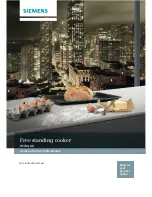
16
COOKING WITH FORCED AIR
Fan cooking is more economical and
quicker than cooking in a conventional
oven .
The moving hot air surrounds the food
and penetrates it more quickly than in a
conventional oven .
The oven can be filled with different dishes
all requiring the same cooking temperature .
Subtract 10 minutes per hour for every dish
requiring a cooking time of more than 1
hour and reduce the heat by 10-20°C; the
hotter the oven, the more the temperature
can be reduced .
Generally, there is no need to pre-heat
the oven, but it is advisable to pre-heat for
about 5 minutes to ensure the best results;
use the indicator light as a guide, it goes
out when the set temperature is reached .
Fan cooking is ideal for gelatine based
dishes and softening ice cream - a
microwave oven is much too strong for
these dishes .
Cooking yeast based dishes is also
speeded up this way . If the oven door has
been opened, the oven quickly regains its
temperature once the door is closed .
5 - BOTTOM MAIN OVEN
Attention: the oven door becomes
very hot during operation.
Keep children away.
SWITCH AND TEMPERATURE
SELECTOR
Turn the selector knob (fig. 5.1) to the
required function .
0
OFF - as per fig. 5.1
The oven light is switched on .
The fan operates without the
heating element, this function
can be used for defrosting .
50-250°C
The oven light is switched on .
The oven temperature can be
set between 50°C - 250°C .
The set temperature has been
reached when the temperature
indicator light goes out .
Several different meals may
be cooked simultaneously
on various shelves, as the
heated air circulates evenly
throughout the oven .
The hot air system cooks more
quickly than conventional
static system, therefore the
temperature should be set
15°C - 20°C below the values
recommended in your recipe
books .
The oven door may be
opened briefly while cooking
as any heat losses are quickly
recovered when the door is
closed .
WARNING:
The door is hot, use the handle.
During use the appliance becomes hot.
Care should be taken to avoid touching
heating elements inside the oven.
Fig . 5 .1
















































